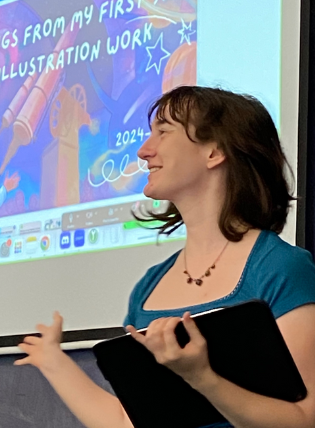Monthly Meeting: July 2025 – Illustrator Alyssa Russell
Created August 19, 2025 by Nataly Allimonos
Read up on illustrator Alyssa Russell’s honest and upfront look at what it’s really like to break into the world of children's book illustration.
July’s Monthly Meeting introduced us to Alyssa Russell, who engaged the audience with stories of her first year as a professional illustrator. Soon to be published, Allyssa shared a wealth of candid advice to illustrate her journey. She outlined how to get the client and how to get the career. With four books currently in the works, her debut picture book, FANNY’S BIG IDEA, is due out this November.
Alyssa is a graduate of Ringling College of Art and Design. She is passionate about the use of fantasy as a medium for emotional expression through heartfelt characters and meaningful narratives. She is aesthetically drawn to light, gesture, and expressive use of texture stemming from her love of vintage illustrators such as Hilary Knight, Garth Williams, and Maurice Sendak.
MEETING HIGHLIGHTS:
How to Get the Client:
- To become a professional children’s book illustrator, an art school degree is helpful, but is not necessarily required; the School of Visual Storytelling is an example alternative
- Be prepared: illustrating children’s books is a very slow process; most illustrators rely on another source of income
- Agents are most often the gatekeepers; Alyssa’s agent is Christy Megill, with The Cat Agency, Inc.
- It took Alyssa about five years (after graduating art school) to sign with an agent; it only took a few months to acquire a job after signing with an agent
- After signing, her portfolio was refined (with the agent’s guidance) prior to being announced by the agency
- Publishers Alyssa is currently working with: Harper Collins, Sleeping Bear Press, Little Bee Books, Penguin Random House
- To standout in an overwhelming sea of talented illustrators: identify your style, study current trends, and decide what subjects resonate with you—then, combine these three elements
- Keep in mind the main goal: to sell the book
- Discover and refine your favorite medium/s; explore both traditional and digital mediums
- Alyssa’s favorite medium is digital (due to editing speed)
- Find your niche (but avoid pigeonholing yourself)—explore and narrow down your interests, style, and genres
- Alyssa’s current niche/brand includes Jewish themes, sentimental illustrations, soft and sweet styles, and vintage lighting
How to Get the Career:
- Utilize Instagram; peruse the work of other artists and investigate what jobs they are acquiring
- Making a living solely as an illustrator is not easy or reliable
- For traditionally published contract-based illustrator projects, typical advances may be: $10-35k, which after common 25% agent fees and taxes becomes $6-20k; and a goal of 2-3 books per year may be realistic for some illustrators
- Additional income that supports being a full-time illustrator may be achieved through paid speaking engagements, hosting workshops, freelance work, online store sales, royalties, and selling illustrations to other businesses
- Remember: if you create art you do for yourself without publishing it, you can sell and resell it over time for added income
- Patreon is a website to consider for content marketing; 3-Point Perspective is a recommended podcast
- Be selective in accepting jobs; if you say no to a job that is not the right fit or pay, better opportunities will likely follow
- Working with Art Directors: after receiving a manuscript, provide full sketches in black and white; be prepared to receive notes for every page and every illustration; focus on ensuring the story makes sense to kids; if you feel strongly about a particular illustration, don’t be afraid to voice your opinion or defend your creative choices
- Note that imposed deadlines can sometimes be adjusted if you inquire; know when to say no—don’t overwork yourself if it means you’ll end up hating your job
Portfolio Advice:
- Include around 10 solid pieces, in the style in which you want to work
- Market your skill sets, personality, and knowledge base in your portfolio
- Budget time for illustration research, which sometimes can take longer than actually illustrating
- Participate in critique groups
- Alyssa creates illustrations in Procreate and edits in Photoshop
- Create many layers to make editing easier
- Example layers: all hair, all skin, all outfits, backgrounds in various groupings
- Consider providing a project-specific color palette to Art Directors
- Save and savor the compliments you receive!
- Caveat: Alyssa was initially told she was “not ready yet,” so she improved her illustration consistency, practiced drawing faces, and set out to emulate the caliber of work that she wanted to do … then, she proved she was “ready!”
